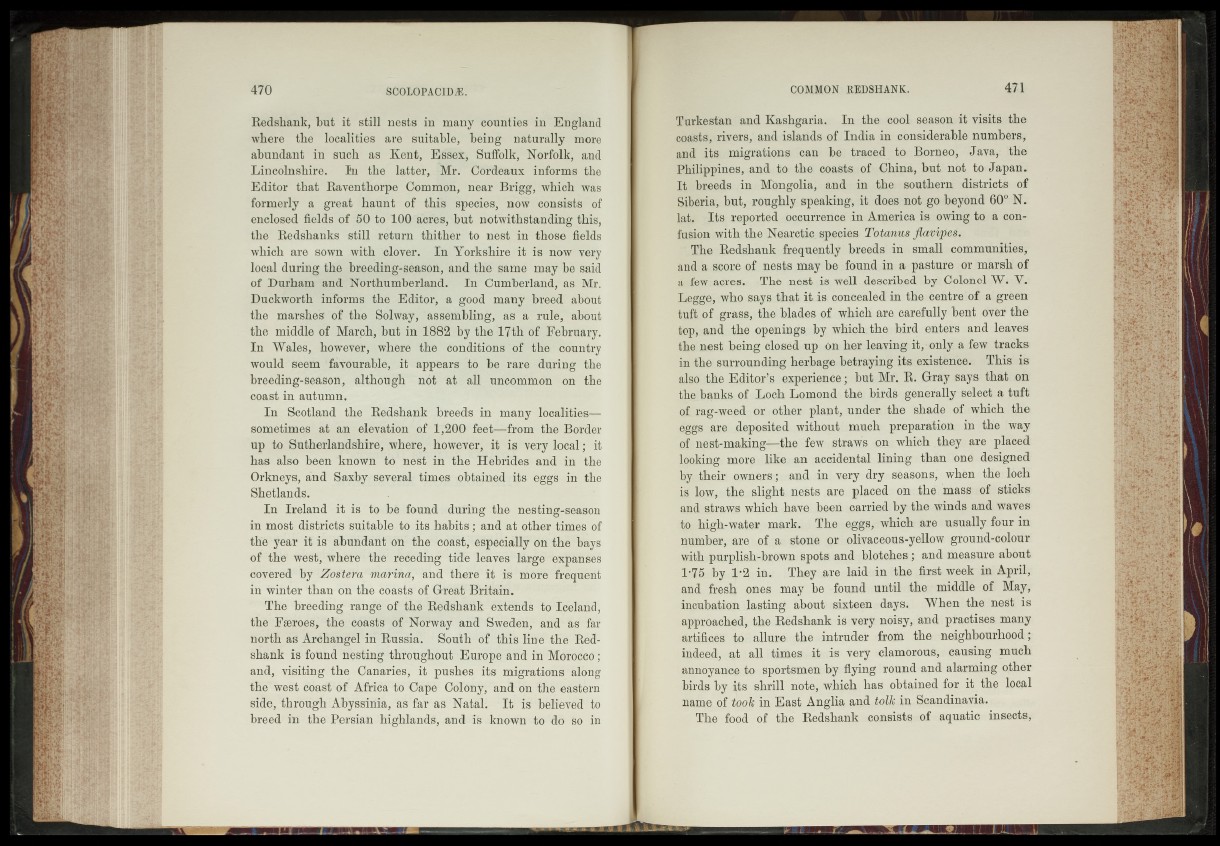
Redshank, but it still nests in many counties in England
where the localities are suitable, being naturally more
abundant in such as Kent, Essex, Suffolk, Norfolk, and
Lincolnshire. In the latter, Mr. Cordeaux informs the
Editor that Raventhorpe Common, near Brigg, which was
formerly a great haunt of this species, now consists of
enclosed fields of 50 to 100 acres, but notwithstanding this,
the Redshanks still return thither to nest in those fields
which are sown with clover. In Yorkshire it is now 'wery
local during the breeding-season, and the same may he said
of Durham and Northumberland. In Cumberland, as Mr.
Duckworth informs the Editor, a good many;3>reM about
the marshes of the Solway, assembling, as a rule, about
the middle of March, but in 1882 by the 17th of February.
In Wales, however, where the conditions "of the I Country
would seem favourable, it appears to be rare during' the
breeding-season, although not at "all uncommon on "the
coast in autumn.
In Scotland the Redshank , breeds -raj- many localities—
sometimes at an elevation of 17200 feet—from the Border
up to Sutherlandshire, where, however, it is, very local ; it
has also booh ’known tö-nekt in 'thé Hebrides and f®i4t’he
Orkneys, and Sa-xby- several times obtained ifs eggs in the
Shetlands. .
In Ireland it is to . be found during the nesting-season
in most districts suitable - to its habifif and at other times of
the year it is abundant oh the coast-, ‘especially on the %ays
of the west, where the receding-tiro leaves Mrge:‘e^ïcMés
covèred by 'T2foêïérar>iH<fó^a/'ÏÏh& there it is ruéïe ^eguéht
in Winter than- Oh the Soams'Of Great Britain.
The breeding range of thé Redshank éxtbnds to Iceland,
the Faeroes, the, coasts of Norway and Sweden, and‘l s far
horth as Archangel in Russia. South of this MïÉr* thé Redshank
is'1 ïoühd nhsling'-throughout Eufopè'amt inriMoroccó;
and,, visiting the Canaries, it pushes its migrations ’along
the west coaét'óf Africa to Capè Colony;-and on thé eifstêrn
Side, 'through Abyssifiia, -as-far as 'Nafbl; It is- Believed to
breed in the Persian highlands, and*4k Jaiown .to do So in
Turkestan and Kashgaria, Ja the cool season it visits the
coasts, rivers, and islands of India in considerable numbers,
and its migrations can be traced, to Borneo, Java, the
Philippines, and to- the. coasts, of China, but not to Japan.
It breeds in Mongolia, and in .the,* southern, districts of
Siberia, hut, roughly speaking*, it does not .go beyond 60° N.
lat. Its reported occurrence? in America is owing to a com
fusion with' the Nearctic. speciés Totanus flayipms.
■ vThe Redshank frequently breeds in small communities,-
and a score of nests may be.found.hu a pasture or marsh of
a few. acres. :Thé nest is well described by . Cölohel W. Y.
Legge, who says that ills concealed in the centre-of a green
tuft, of , grass, the blades of which are carefully bent over the
top, and the openings., by which,the, bird enters and leaves
nest being.ülpsedup o,n her leaving.lt,• only, a few tracks
indhe surrounding herbage betraying its existence.- This is
also, the Editor’s experience; but Mr; R. Gray says-' that on
the banki-pf-Loch Lomond the birds generally select a tuft
of. rag-weed or other* plant., under the shade of which the
dggs are; deposited without.;,.-much preparation in the way
oftnest-making-—the fewt? straws Qn which they are placed
teking more like an accidental lining than iina designed
by -their owners; and in very dry, seasons, when the löch
is low, the slight nests. are placed on the mass of sticks
and straws which have been carried by the winds and waves
to high-water mark. The eggs,- which are usually four in
number, are of a:: stone or olivaceous-yellow ground-colour?
with purplish-brown spots and blotches ; and measure about
m m l'%in-. They-.are daidi in the .first week in April,
and freslj ones may be found until the * middle of May,
incubation lasting about sixteen days.; When the nest is
approached, the Redshank is very; noisy, and practises many
artjfi&ëf fo allure th e , intruder from the- neighbourhood;
indeed, at all . times -it is, very clamorous, causing mueh
annoyancedlO sportsmen by flying round and alarming other
birds by |ts shrill note^ which has obtained, for it the local
name of took in. East Angli-a andJoZAin Scandinavia. -
The fopd of the Redshank consists of aquatic insects,: